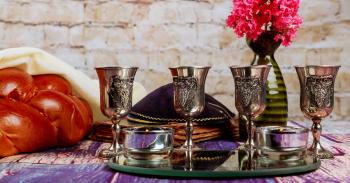
Jewelry is the most universal means of expressing something special, maybe to indicate belonging to a group or as a symbol of individuality, to pronounce your social status or to enhance your own or someone else’s inner beauty, or, perhaps, simply to show your love for another. And the notion of jewelry is old, truly ancient, predating history itself. Archeological digs in the caves of our prehistoric ancestors tell us of jewels created roughly 100,000 years ago. These first jewels were made of animal bones, stones and wood, and were of a more practical nature, helping “cavemen and women” to secure their clothing or connect pieces of leather. Archeological evidence shows, however, that our predecessors soon began using these trinkets to adorn themselves and as ornaments.
With all that said, for the Jewish people, jewels were never just decorative. There are many examples of gems and trinkets that bore important and spiritual meaning, not only during the times when they were actually worn and displayed, but also as heirlooms, throughout history and up to modern times. Whether it is the choshen, the mezuzah, the star of David, the hamsa, the chai, etc. or be it one of the countless amulets, kabbalastic ornaments, wedding rings or bracelets. Judaica jewelry is a microcosm of the Jewish faith and tradition, symbolizing protection, love, prosperity, and even Jerusalem, the golden queen.
Let us explore, and celebrate, some of the most significant jewels and iconography of the Jewish tradition, many of which can be found on our site, here.
“I decked thee also with ornaments, and I put bracelets upon thy hands, and a chain on thy neck. And I put a jewel on thy forehead, and earrings in thine ears, and a beautiful crown upon thine head. Thus wast thou decked with gold and silver; and thy raiment was of fine linen, and silk, and broidered work; thou didst eat fine flour, and honey and oil: and thou wast exceeding beautiful, and thou didst prosper into a kingdom” (Ezekiel 16:11-13)
To provide context for the “Jewish perspective” on jewelry, we look to the way in which the scriptures and Jewish lore often relate to the city of Jerusalem as a woman or wife, on whom we bestow jewels, or as a jewel itself. In the beautiful passage above from the book of Ezekiel, Jerusalem is both the queen, coronated and bejeweled, and the eternal, prosperous kingdom of the Jewish people. In another instance, the book of Lamentations refers to the temple of Jerusalem as the crown itself that has “fallen from our head”.
A story from pre-Talmudic times tells us of Rabbi Akiva, who gave a city of gold to his wife. The wife of Rabban Gamliel became jealous of her, and having reported this to her husband, Rabban Gamliel replied: “When have you done for me what she has done for him? She has sold the braids on her head so that he would be able to study Torah”.
The “city of gold” given to Rabbi Akiva’s wife in appreciation of her devotion, is said to be a beautiful golden crown, donned in the past by prominent Jewish women. The story of Rabbi Akiva and the city of Jerusalem would later serve as inspiration for the lyrics in Neomi Shemer’s beloved ballad, “Jerusalem of Gold”: Jerusalem of gold, and of bronze, and of light/ Behold I am a violin for all your songs”.
The crown of Jerusalem, real or figurative, is not the only jewel or charm attested to in our scriptures and throughout Jewish history. In the bible, jewels were a symbol of one’s wealth and social status. Archeologists and Jewish historians speak of the skills and fine craftmanship of Jewish goldsmiths, and Jewish texts frequently mention chains, rings, earrings, nose rings and more.
Here are some of the most well-recognized Jewels making appearances in the annals of the Jewish people.
“Whenever Aaron enters the Holy Place, he will bear the names of the sons of Israel over his heart on the breastpiece of decision as a continuing memorial before the Lord. Also put the Urim and the Thummim in the breastpiece, so they may be over Aaron’s heart whenever he enters the presence of the Lord” (Exodus 28:29-30)
So God commanded Aaron, brother of Moses and father of high priests, to don the “Choshen” upon entrance to the temple. The Choshen was a priestly breastplate adorned by twelve jewels, representing the twelve tribes of Israel. It served to commemorate God and the majesty of the temple, as well as to link between God and the realm of man in times of turmoil.
There is much speculation surrounding the source of the Star of David in Jewish tradition. Its name is thought to be derived from the embellishment on King David’s shield, and there is archeological evidence indicating use of the emblem in synagogues as early as the Second Temple Period (between 516 BCE and 70 CE). In the twentieth century, it would serve both as a painful mark of Nazi oppression, and, conversely, as the centerpiece in the national flag of the independent State of Israel. Regardless of its precise origin, the Star of David has been the most prominent symbol of the Jewish people for almost the entirety of our existence, encapsulating complex history and a people’s struggle towards freedom - an icon of divine protection, spirit, and strength.
“Fix these words of mine in your hearts and minds; tie them as symbols on your hands and bind them on your foreheads… Write them on the doorframes of your houses and on your gates” (Deuteronomy 11:18-20)
With these words, God command the Jewish people to affix mezuzahs to the entrance of their homes and to wear tefillin in morning prayer. These mitzvot serve as a constant reminder of God’s singularity and omnipotence, and of the Jewish people’s dedication to their almighty lord.
Being placed so conspicuously in homes of Jewish people, there were long stretches of time when Jews did not post Mezuzot (plural of Mezuzah) in their doorways for fear of persecution. Today, with many, if not most Jews wishing to proclaim their identity, Mezuzot have become more and more ornamental, often artistic and spectacularly bejeweled.
Chai is the Hebrew word for “alive” or “living”. In gematria, the long-held Jewish tradition of assigning a numerical and spiritualistic value to a word based on its letters, the Hebrew letters “חי” equate to the number 18. Consequently, both the number and the word are symbolic of good luck, life and prosperity, and the notion of Chai is the base of many Jewish traditions, such as giving gifts in multiples of eighteen. Chai, as a symbol, originated in Medieval Spain, and the custom of using it as an amulet of luck and protection most likely began in 18th century Eastern Europe.
The Hamsa talisman is a symbol in the form of an open palm, often depicted with an eye in its center. It is of great significance to both Jewish people and Muslims, thought to have originally represented the five pillars of Islam. The Hamsa became a popular form in Jewish Sephardic communities, and is mostly used as a protective amulet against the ‘evil eye’. Besides functioning as a token of protection, the Hamsa was also believed to have the power to invoke God, with the five fingers of the Hamsa signifying the five books of the Torah. Nowadays, the Hamsa is part of the henna ceremony, a Sephardic ritual that occurs before a wedding, in which the bride often dons the Hamsa on a necklace or bracelet.
I am my beloved’s, and my beloved is mine, that feedeth among the lilies.” (Song of Songs 6:3)
The Song of Songs is a series of love poems between a man and a woman, thought to be an allegory to the relationship between God and the Israelites. Traditionally, it is upheld that the Song of Songs was written by King Solomon, and the Song of Songs megillah has been, and still is, extremely influential in Jewish culture. The tension between the Song of Songs as celebrating love between man and woman, as opposed to the relationship between God and his people, has been cause for controversy for centuries on end. Be as the love in the Song of Songs may be, the texts are strewn with mention of Jewels, given as expressions of love.
There is evidence to suggest that the Song of Songs was sung as a wedding song, at least from the days of Chazal. Of course, weddings are an essential component of Jewish tradition and ritual, and at the heart of present day wedding ceremonies we find jewels, in the form of rings that are exchanged between the bridal couple. It is interesting to note that this exchange was not originally part of the Jewish wedding ceremony. The three most vital elements, without which marriage is void, are the “Ndunia”, the “Ketubah” and the consummation of the relationship, none of which are associated with the rings. Even so, exchanging rings has no doubt become a fundamental part of the Jewish wedding custom, with Jewish wedding bands meant to be simple in design and pure in style.
Since biblical days, and well into our own, jewelry and ornamentation have been a key instrument in expressing devotion, faith and divine protection. Symbolism and iconography in Judaica are fundamentally interlaced with the principles and culture of the Jewish people. They are central in the most sacred of ceremonies; they serve as a linking chain between the realm of God and the realm of man, a means for one to convey feelings of love, partnership and spirituality. Judaica jewelry is the invisible thread connecting us to figures of our past; golden cities, extravagant temples, ancient tales and literature; it is the physical testimony of our history; a celebration of Jewish heritage.



